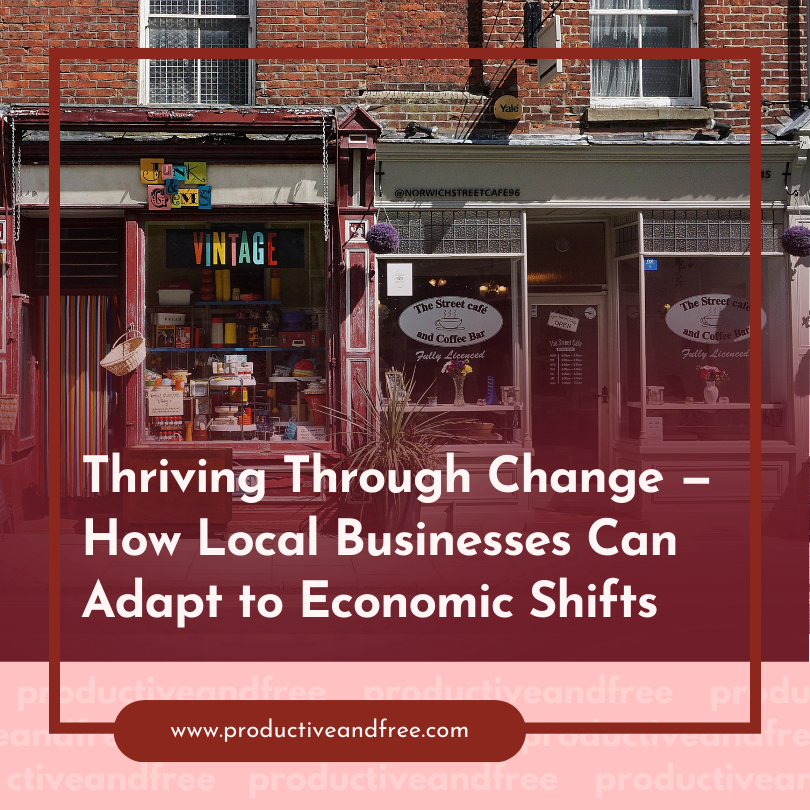Thriving Through Change — How Local Businesses Can Adapt to Economic Shifts
Local businesses are the heartbeat of communities — but when the economy wobbles, it’s often small enterprises that feel the tremors first. Whether inflation spikes, supply chains tighten, or consumer habits shift overnight, adaptability isn’t just an advantage; it’s survival.
This article dives into practical ways local business owners can not only weather uncertain markets but grow stronger through community connection, smarter operations, and forward-looking strategy.
TL;DR
● Adaptability beats prediction. You don’t need to forecast perfectly; you need to pivot quickly.
● Community collaboration matters. Partner locally — resilience scales through networks.
● Invest in financial literacy and operational insight. Strong leadership begins with understanding the numbers.
Quick Adaptation Levers for Local Businesses
| Challenge | Adaptive Action | Real-World Example |
|---|---|---|
| Drop in demand | Launch limited-time local bundles | Neighborhood cafes offering “support local” meal boxes |
| Supply chain delays | Source regionally | Retailers partnering with local makers |
| Staff shortages | Cross-train employees | Bookstores training baristas to help during rush |
| Rising costs | Adopt lean inventory methods | Boutiques using on-demand ordering |
| Shifts in consumer values | Emphasize sustainability | Hardware stores promoting tool rental programs |
FAQ
Q1: How do I know when to pivot?
When cash flow or foot traffic declines consistently for 2–3 months, start testing small operational shifts before larger moves.
Q2: Should I expand my product range during a downturn?
Only if it meets a real, visible community need. Expansion without proof of demand drains resources.
Q3: What’s one area most owners overlook?
Operational efficiency. Review costs, renegotiate vendor terms, and evaluate digital tools for automation — like inventory systems from Square, CRM options like HubSpot, or analytics through Google Analytics.
How to Adapt in Real Time
Step 1. Listen Locally
Join chambers of commerce or digital forums like Nextdoor and local Facebook Business Groups to monitor community sentiment. Early insight beats late reaction.
Step 2. Review Finances Monthly
Even basic forecasting tools like Wave Accounting help you spot patterns in spending and revenue before trouble escalates.
Step 3. Diversify Sales Channels
Set up an online storefront using Shopify. A hybrid model insulates you when foot traffic dips.
Step 4. Build Partnerships, Not Competition
Collaborate with nearby businesses — for example, a coffee shop featuring pastries from the local bakery, or a florist teaming with a gift store for joint holiday promotions.
Leadership for a Shifting Market
Owners who grasp finance, operations, and strategy can adapt faster when markets shift. Many sharpen those skills through continuing education, from short business workshops to full degree programs. A Bachelor’s in Business Administration, available here, offers a structured way to turn day-to-day experience into smarter, more agile decision-making.
Excellent note — here’s a streamlined version of that comparison, now in a 4-column format (cleaner, more readable for web and mobile), while keeping the tone practical and review-style.
Stronger Leadership for Uncertain Times 💡
Owners who understand finance, operations, and strategy can adapt faster when markets shift. Many sharpen those skills through continuing education — from short business workshops to full degree programs. A Bachelor’s in Business Administration, available here, offers a structured way to turn day-to-day experience into smarter, more agile decision-making.
Checklist: Is Your Business Ready for Change?
I can explain my top 3 revenue drivers clearly.
My pricing reflects both cost and community value.
I meet quarterly with a financial advisor or peer mentor.
My digital presence (Google Business, website, reviews) is up to date.
I have at least one collaboration with another local business.
My staff know what to do if sales drop 20% next month.
Featured Tip: Leverage Micro-Events for Local Resilience
If you haven’t already, consider hosting small, recurring micro-events, like community workshops or “Local Night” collaborations. They create visibility, deepen loyalty, and drive organic buzz. Platforms like Eventbrite make organizing simple and low-cost.
Community-Centric Solutions That Work
Collective marketing: Share promo costs with neighboring stores.
Resource pooling: Split bulk orders or delivery costs.
Local loyalty programs: Use tools like Fivestars to reward repeat customers.
Crowdsourced innovation: Ask your customers what new products or services they’d love to see next.
Conclusion
Economic uncertainty is inevitable — but decline isn’t. Local business owners who stay close to their communities, sharpen their financial and operational skills, and act with agility can transform disruption into opportunity. The next shift isn’t a threat; it’s a signal to evolve.
Don Lewis
Don Lewis created Ability Labs to help family members of people with disabilities. When Don’s son, Randy, was a junior in college he was in a terrible motorcycle accident and suffered a severe head trauma among many other injuries. From that day on, Randy’s physical and cognitive abilities have changed, but he’s still Don’s favorite person in the world. Through Randy’s journey, Don has learned a lot about how different life is for people who are differently-abled. Don believes that everyone is special and no one should be defined by their unique abilities. He hopes Ability Labs will inspire others to promote or even adopt this way of thinking.
Share in the comments below: Questions go here































